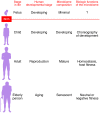The microbiome revolution
- PMID: 25271724
- PMCID: PMC4191014
- DOI: 10.1172/JCI78366
The microbiome revolution
Abstract
The collection of bacteria, viruses, and fungi that live in and on the human body, collectively known as the microbiome, has recently emerged as an important factor in human physiology and disease. The gut in particular is a biological niche that is home to a diverse array of microbes that influence nearly all aspects of human biology through their interactions with their host; new technologies are beginning to reveal important aspects of host-microbe interactions. Articles in this Review series address how perturbations of the microbiota, such as through antibiotic use, influence its overall structure and function; how our microbiome influences the impact of infectious agents, such as C. difficile; how our microbiome mediates metabolism of xenobiotics; how the microbiota contribute to immunity as well as to metabolic and inflammatory diseases; and the role of commensal microbes in oncogenesis.
Figures

References
-
- Rosebury T. Life On Man. New York, New York, USA: Viking Adult; 1969.
Publication types
MeSH terms
Substances
Grants and funding
LinkOut - more resources
Full Text Sources
Other Literature Sources

